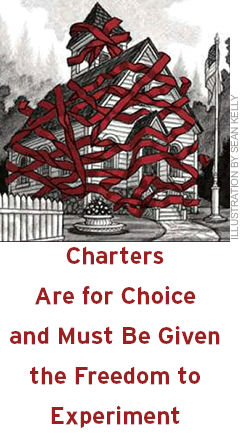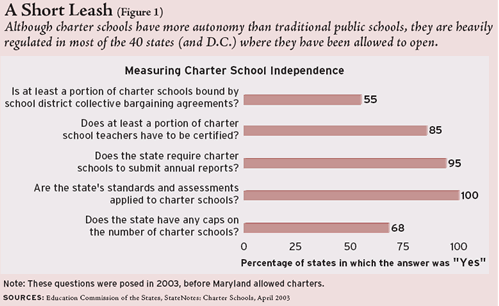
Of the many arguments for charter schools, one is crucial: that charters should be deliberately, thoughtfully, boldly different from existing mainline public middle and high schools.
The evidence of the ineffectiveness of the traditional design of K-12 education, especially that of middle and high schools, serving both rich and poor, is overwhelming. The trail goes back for decades, from John Goodlad’s massive inquiry, summarized in A Place Called School (1984), and Arthur Powell, Eleanor Farrar, and David Cohen’s The Shopping Mall High School (1985), to a string of studies starting in the late 1950s by James S. Coleman and scores of others. Journalists’ accounts ring similar bells: Frederick Wiseman’s searing 1960s documentary film “High School,” Charles Silberman’s 1970 Crisis in the Classroom, Samuel Freedman’s 1990 Small Victories, Mark Edmundson’s 2002 Teacher, to name just a few. They all tell a remarkably common story. I know of no research that argues that the secondary-school design with which we are all so familiar is effective, by any measure.
Age-graded institutions where “delivery” is the dominating education metaphor are the norm. So are schools where teachers have 120 or more students to get to know (with this 120 shuffled at the end of each semester); where serious learning is broken up into snippets of 50-minute “subject matter periods” arranged in no intellectually coherent order; where assessment keeps knowledge tightly packaged in separate intellectual domains; where short-term memory work is rated as deserving the highest value at the expense of original, long-term analytic work; and where the intellectual engine of the curriculum comes at most students and teachers as a list of subjects and skills, usually far too long for the careful savoring and devoted practice that leads to deep understanding and worthy habits. As the research shows, these so very familiar conditions poorly serve children, their teachers, and, ultimately, the culture.
The waste is prodigious, and the frequently observed (and unsurprising) cynicism of all too many adolescents about serious intellectual work is deeply disheartening. The title of Denise Pope’s painstakingly documented recent book is as blunt as it is illuminating: “Doing School”: How We Are Creating a Generation of Stressed Out, Materialistic, and Miseducated Students. That title is less hyperbolic than many of us wish to believe.
A Vive la Difference Standard
If one takes this tidal wave of research and reportage seriously, one cannot responsibly push aside fresh school designs that challenge the premises apparent in the schools that we have inherited. Indeed, we must encourage new designs, risky as that may appear. Accordingly, any policy that drives charters into old molds-making them, in effect, “look and act familiar” as worthy expressions of the existing “system,” producing students who do well primarily on tests organized in ways that reflect this system-undermines the sound intent of the charter idea. (See Figure 1.) Mindlessly administered, NCLB could have the effect of driving charter schools into discredited routines, in effect, killing them.

Charters (and cousins such as district-sponsored pilot schools) should be different, should march to promisingly better tunes. Policymakers should insist on that. If these schools are different, however, how to evaluate them? As one of the founders, with my wife, Nancy Faust Sizer, of the Francis W. Parker Charter Essential School, and as its acting co-principal, again with Nancy, during the school’s fourth year, I have personal experience with the admirable Massachusetts system of performance review. The heart of it is rigorous in-school inspection of student work; of faithfulness of the school to the terms of its charter; of the mood, morale, and intensity of the school, its faculty, students, and families. Test scores are part of it, but hardly its center. Inspectors randomly examine student portfolios of work, “shadow” students and teachers, witness classes, talk confidentially with staff, students, and parents and guardians. They get a fair sense of the place as a whole. Full-scale inspections come every five years, supplemented with annual focused visits. On the basis also of rigorous inspection, the school is a member of the New England Association of Schools and Colleges, the regional independent accrediting organization. Parker’s students take the MCAS (Massachusetts Comprehensive Assessment System), as well as the Stanford 9 (now 10), and SATs. There are data arising from such indexes; but these are not the only or the most compelling data. There is far more to it. As there should be.
Parker’s design is not traditional. Students enter at “seventh grade,” but move upward over three “divisions” on the basis not of their age but of their publicly exhibited performance. There is one focused course of study (history, language-English and Spanish-and the arts; mathematics, science, and technology; and health); everyone is enrolled in it; an appropriate path for each student is developed (every child has a “personal learning plan”); most teachers have responsibility for no more than 50 students (this on a per-pupil budget that is the same or less than in nearby public secondary schools). The basic pedagogy is provocation, question asking, “do it over and over until you get it right,” “apply what you think you know in this new, even unexpected situation.” In these and other ways Parker is deliberately different (and, incidentally, closer to the way the world beyond school actually works), and we are blessed to be in a state that honors, values, and, in its practice, protects that difference. The Commonwealth of Massachusetts is “results oriented,” but it demonstrates that there are many fashions of “results,” many ways of achieving them, and several ways of measuring them.
The reality is that there is no such thing as an admirable manner of “doing school”: our children and our communities are too richly varied for that. Policy that stiffens the grip of any one narrowly defined “system” is sure to result in seriously mixed results. There are many good roads to a fine education, and varied travelers along those roads.
NCLB Is Bad-but Good!
I have twice been the principal of a charter school: during 1997-98 at Parker and 1972-81 at Phillips Academy at Andover, Massachusetts; the latter, arguably, the earliest such school in America still in operation. Its charter (allowing it to own property-farms-from which revenue could be raised to pay the costs of the school) was granted by the Massachusetts Revolutionary Legislature in 1778 and signed by its chairman, John Hancock. That document (modified by modern realities) remains in force to this day. In the cases of both Phillips and Parker, separated by more than two hundred years, each school received broad but specified authority from the state, with diplomas granted on the basis of public “exhibitions” and with the expectation-the trust-that the details of the program and its assessment would be creatures of the schools’ immediate community, subject, as deemed necessary, to the inspection by the state or, in the case of Phillips, the local superintendent of (public) schools.
Neither the Andover of the 1970s nor the Parker of the 1990s was perfect, but I make no apology for either. Both pursue high standards, expressed in a rich variety of ways. Both have attracted and hold strong faculty, largely because the teachers know that they have both the exhilaration of shaping their place for learning and an obligation to meet external standards, including the satisfaction of their students’ parents. Both attract substantial numbers of families seeking admission for their children, and by careful selection-at Andover originally done by the master and now by faculty committees and at Parker by state-controlled (blind) lottery-both are able to admit only a small percentage of those applicants.
So why are NCLB and its “external standards” so troubling to educators like me who work today in and for public schools like Parker?
Because, especially at the secondary school level, the academic patterns to be “tested” may excessively reflect the centralized political, and thus pedagogical, wisdom of their times, with which citizens and teachers in a healthy democracy may very often and very reasonably disagree.
Because-and especially in their assessments-they tend to reflect familiar categories: The sharp and often distorting distinctions among and between “subjects”; age grading; the value placed on quick recall; the dumbing down of the quality and grace of expository prose to make it fit into some sort of rating scheme; the overload of material to be covered, usually the inevitable result of intracommittee ideological logrolling, which leads to a bit of this and a dollop of that; the almost absolute denial of a value placed on individual ingenuity, craggy but provocative thinking, sustained work, and desirable variety; the lack of interest, signaled by the assessment apparatus, of the virtues of fairness, good character, and imagination.
Because they represent-or could soon represent-something never before seen in American education: a centrally directed, narrow categorization of just what a child should know and be able to do and an excessively consistent way of assessing all that. This process, perhaps necessarily wrapped in psychometric mumbo-jumbo far beyond the reach of the common, smart citizen, is, at its egregious worst, Orwellian.
All that said, NCLB is in fact also an inspired and necessary corrective to the sloppy, often thoughtless reality of existing American education. NCLB and the state initiatives that preceded it have served the purpose of putting in front of all citizens the stunning weaknesses of our schooling system, especially as it serves-or fails to serve-its most vulnerable young citizens. The test results, even with their technical flaws, have exposed the appalling neglect that we as a people have long recognized but have never fundamentally addressed. Americans started down this worthy road of exposure during the 1960s, with passage of the Elementary and Secondary Education Act of 1965, of which NCLB is technically the reauthorization. But we dodged the deep implications of this exposure thereafter, preferring stirring statements to sophisticated reform and necessary finance.
Ends and Means
The end of No Child Left Behind is worthy, profoundly reflecting a democracy’s need for an educated citizenry. It is long overdue, but its current means may end up, save at the embarrassing margins, hurting the schools more than helping them, turning them into test-prep places and driving away the imaginative teachers that each of us as a parent wants in contact with our children. Test prep is a parody of serious education. While the scores from good standardized tests tell us something about a student, they hardly tell us everything about that student, much less that student’s school. Policy that blithely ignores these realities is destructive policy.
Which brings me back to charter schools and their relatives in mainstream school systems that are, by bearing witness, pushing their colleagues in better directions. These enterprises deserve vigorous encouragement and support for their quality, variety, and imagination. For their own as well as for the public’s benefit, they need a program of serious, sustained, independent assessment, based on the exhibited quality of an agreed-upon scope of work. This evaluation can be achieved with a mixture of inspection and varied forms of standardized testing. It can also be helped by policies that extend parental choice among schools, allowing a market to play a proper part in the process: Family interest represents an important kind of assessment.
Some of us in the charter world (and beyond) already see the merits of these interconnected approaches. May our tribe increase.
Theodore R. Sizer is author of The Red Pencil: Convictions from Experience in Education (Yale University Press, 2004), and coauthor, with Deborah Meier and Nancy Faust Sizer, of Keeping School: Letters to Families from Principals of Two Small Schools (Beacon Press, 2004).


